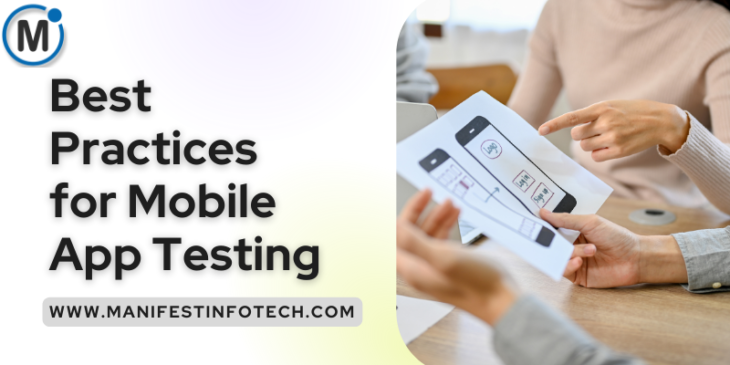
Mobile applications have become an integral part of our daily lives, empowering us with convenience, connectivity, and functionality. As the demand for seamless mobile experiences rises, the importance of robust and reliable mobile app testing cannot be overstated. Ensuring your app works flawlessly across diverse devices and platforms requires adherence to best practices in mobile app testing.
𝟏. 𝐄𝐚𝐫𝐥𝐲 𝐓𝐞𝐬𝐭𝐢𝐧𝐠 𝐈𝐧𝐭𝐞𝐠𝐫𝐚𝐭𝐢𝐨𝐧
Integrate testing into the development process from the outset. Adopting a test-driven development (TDD) or behavior-driven development (BDD) approach ensures that testing is not an afterthought but an integral part of the development lifecycle.
𝟐. 𝐃𝐞𝐯𝐢𝐜𝐞 𝐅𝐫𝐚𝐠𝐦𝐞𝐧𝐭𝐚𝐭𝐢𝐨𝐧 𝐂𝐨𝐧𝐬𝐢𝐝𝐞𝐫𝐚𝐭𝐢𝐨𝐧
Account for the diverse landscape of devices, operating systems, screen sizes, and resolutions. Prioritize testing on a wide range of devices to ensure your app functions uniformly across various configurations.
𝟑. 𝐔𝐬𝐞𝐫 𝐄𝐱𝐩𝐞𝐫𝐢𝐞𝐧𝐜𝐞 (𝐔𝐗) 𝐓𝐞𝐬𝐭𝐢𝐧𝐠
Focus on user-centric testing to ensure a seamless and intuitive experience. Test navigation, gestures, screen transitions, and responsiveness to various user inputs across different devices and orientations.
𝟒. 𝐏𝐞𝐫𝐟𝐨𝐫𝐦𝐚𝐧𝐜𝐞 𝐓𝐞𝐬𝐭𝐢𝐧𝐠
Evaluate your app’s performance under different conditions such as varying network strengths (3G, 4G, Wi-Fi), low battery, and limited storage space. Performance testing ensures your app remains responsive and efficient under diverse scenarios.
𝟓. 𝐒𝐞𝐜𝐮𝐫𝐢𝐭𝐲 𝐚𝐧𝐝 𝐏𝐫𝐢𝐯𝐚𝐜𝐲 𝐓𝐞𝐬𝐭𝐢𝐧𝐠
Conduct rigorous security and privacy testing to safeguard user data. Test for vulnerabilities such as data leaks, insecure data storage, and unauthorized access points to ensure compliance with security standards.
𝟔. 𝐀𝐮𝐭𝐨𝐦𝐚𝐭𝐢𝐨𝐧 𝐓𝐞𝐬𝐭𝐢𝐧𝐠
Leverage automation tools to streamline repetitive tests. Automation accelerates the testing process, allowing for quicker iterations and efficient identification of bugs, especially in regression testing.
𝟕. 𝐔𝐬𝐚𝐛𝐢𝐥𝐢𝐭𝐲 𝐓𝐞𝐬𝐭𝐢𝐧𝐠
Engage real users or testers to evaluate the app’s usability. Their feedback provides insights into the app’s intuitiveness, functionality, and overall user satisfaction.
𝟖. 𝐂𝐨𝐧𝐭𝐢𝐧𝐮𝐨𝐮𝐬 𝐓𝐞𝐬𝐭𝐢𝐧𝐠 𝐚𝐧𝐝 𝐌𝐨𝐧𝐢𝐭𝐨𝐫𝐢𝐧𝐠
Implement continuous testing practices to ensure ongoing quality. Monitor app performance post-launch and gather user feedback to address issues promptly.
𝟗. 𝐁𝐞𝐭𝐚 𝐓𝐞𝐬𝐭𝐢𝐧𝐠 𝐚𝐧𝐝 𝐅𝐞𝐞𝐝𝐛𝐚𝐜𝐤 𝐋𝐨𝐨𝐩
Deploy beta versions to a limited audience to gather feedback. Utilize this feedback loop to identify and rectify issues before the official release, ensuring a more polished product.
𝟏𝟎. 𝐃𝐨𝐜𝐮𝐦𝐞𝐧𝐭𝐚𝐭𝐢𝐨𝐧 𝐚𝐧𝐝 𝐑𝐞𝐩𝐨𝐫𝐭𝐢𝐧𝐠
Maintain comprehensive documentation of test cases, scenarios, and results. Clear reporting helps in tracking bugs, understanding patterns, and improving testing strategies over time.
If you are looking for any services related to Website Development, App Development, Digital Marketing and SEO, just email us at nchouksey@manifestinfotech.com or Skype id: live:76bad32bff24d30d
𝐅𝐨𝐥𝐥𝐨𝐰 𝐔𝐬:
𝐋𝐢𝐧𝐤𝐞𝐝𝐢𝐧: linkedin.com/company/manifestinfotech
𝐅𝐚𝐜𝐞𝐛𝐨𝐨𝐤: facebook.com/manifestinfotech/
𝐈𝐧𝐬𝐭𝐚𝐠𝐫𝐚𝐦: instagram.com/manifestinfotech/
𝐓𝐰𝐢𝐭𝐭𝐞𝐫: twitter.com/Manifest_info
#MobileTesting #AppTesting #QAinMobileApps #MobileAppQuality #AppDevTesting #UXTesting #PerformanceTesting #SecurityTesting #AutomationTesting #UsabilityTesting #BetaTesting #ContinuousTesting #MobileDevTips #TestingStrategies #QualityAssurance #TechQAInsights #AppFeedback #TestingDocumentation #TestingBestPractices #MobileAppDevelopment